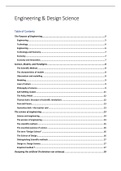Notes de cours
Summary Engineering and design science methodologies (2016TEWMHB)
- Établissement
- Universiteit Antwerpen (UA)
The summary provides a comprehensive understanding of the methodologies and tools used in engineering and design science, and how they can be applied in the field of management. Got me a 16/20.
[Montrer plus]



